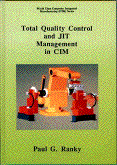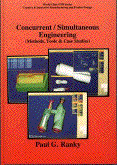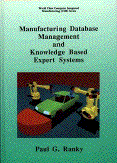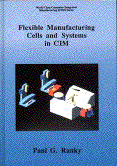Email: cimware@cimwareukandusa.com

Email: cimware@cimwareukandusa.com

Our high quality textbooks are aimed at undergraduate and graduate engineering, management and computing courses at university and college level as well as for professionals in industry. Each book is packed with excellent methods, industrial and research case studies and examples, showing how the methods work in industry and research.
Our concept of object oriented, flexible and modular instructional design, enables students, educators and professionals in industry to use and integrate our books, videos on CD-ROMs and our interactive multimedia CD-ROMs, as well as our Internet-based support material with their own material, makes our products special and in high demand by over 25000 satisfied customers world-wide.
Please note, that you can combine our books with Interactive Multimedia CDs. (Jump to Multimedia CD-ROMs).
(Book only US Dollar price) or (Book only Pund Sterling price) or (BEST DEAL! Book/CD combo US Dollar price) or (BEST DEAL! Book/CD combo Pund Sterling price) (More about the Author) or (More about the Multimedia CD-ROM!) or (Email your Order!)
 Contents: General introduction and foundation. What is Total Quality? Traditional versus Total Quality. What is CIM and why is it important from a Total Quality Management point of view? How can we achieve Total Quality? Computer Aided Production Management and Control (CAPM) and JIT from a Total Quality point of view.
Contents: General introduction and foundation. What is Total Quality? Traditional versus Total Quality. What is CIM and why is it important from a Total Quality Management point of view? How can we achieve Total Quality? Computer Aided Production Management and Control (CAPM) and JIT from a Total Quality point of view.
Chapter 1. Computer Integrated Manufacturing strategy. CIM as a business, communications, JIT and Total Quality Management strategy. Human aspects. Ways of forming the CIM and Total Quality team. The CIM/Total Quality proposal and plan. Managing implementation. Measuring and evaluating the results. A summary of TQ lessons learnt...
Chapter 2. Total Quality Control and Information System. Total Quality: the state of the art. Total Quality control. Total Quality subsystems. The elements of Quality Systems (BS5750 and ISO9000). Total Quality modelling. Information System design.
Chapter 3. CMMs and in-cycle gauging. Contact inspection principles and an overview of Co-ordinate Measuring Machines (CMM). Typical CMM configurations and selection criteria. CMM touch trigger probes and their application areas. CMM programming methods. CMM qualification. CMM errors... In-cycle gauging methods. Contact and non-contact sensing and inspection methods, tools & technologies.
Chapter 4. Machine vision systems. Introduction to machine vision systems. Machine vision research. The fundamentals of machine vision hardware and software systems. Case study: Image segmentation using different threshold algorithms.
Chapter 5. Statistical quality control methods. Mathematical models. Reliability. Variation and the control chart. Histograms. Pareto diagrams. Ishikawa (fishbone) diagrams. Scatterplots and examples.
Chapter 6. Total Quality. Methods and implementation. Kanban. Deming's rules. The Taguchi method and some applications. Just-In-Time. JIT rules in practice; Results achievable with JIT).
Chapter 7. Industrial case studies. Yamazaki's approach to Total Quality and JIT. IBM's approach to automated solder joint inspection.
Chapter 8. Total Quality system installation management. A generic CIM & TQ project planning framework. Total Quality and JIT project management rules. (Project definition; Project organisation; Project team and teamwork; Project planning and control; Project records; Financial project control).
Appendix: A glossary of Total Quality Control, JIT and CIM terms. About the World Class CIM book series. Index (At the end of each Chapter: Review questions and problems. References and further reading.)
(Book only US Dollar price) or (Book only Pund Sterling price) or (BEST DEAL! Book/CD combo US Dollar price) or (BEST DEAL! Book/CD combo Pund Sterling price) or (More about the Author) or (More about the Multimedia CD-ROM!) or (Email your Order!)
 Contents: General introduction, foundation and
strategy. Innovate and develop new products and processes; Product design and manufacturing needs an object oriented approach; Desktop design, manufacturing and rapid prototyping; New management thinking and methods are needed; Teamwork; The most important Concurrent Engineering principles. Concurrent, or Parallel Engineering at Rolls-Royce Motor Cars Limited. Interactive multimedia.
Contents: General introduction, foundation and
strategy. Innovate and develop new products and processes; Product design and manufacturing needs an object oriented approach; Desktop design, manufacturing and rapid prototyping; New management thinking and methods are needed; Teamwork; The most important Concurrent Engineering principles. Concurrent, or Parallel Engineering at Rolls-Royce Motor Cars Limited. Interactive multimedia.
Chapter 1. Concurrent Engineering information system models. CIM and Concurrent Engineering. The CIMpgr method, toolset and diagrams. A methodology for supporting the product innovation process. The sources for new product designs; The research method and toolset.
Chapter 2. Engineering Database (EDB) and Engineering Data Management (EDM). Engineering Data Interchange (EDI) and Engineering Data Management (EDM). Product data management; The Engineering Database (EDB); Typical application programs. Electronic Data Interchange (EDI) and Engineering Data Management. Object Oriented (OO) engineering data modelling and management.
Chapter 3. Failure Mode and Effect Analysis. FMEA: a methodology for capturing product, process and system related failures. Design, Process and System FMEA. The management of FMEA.
Chapter 4. Quality Function Deployment (QFD). The QFD methodology and terminology. The "Whats", or the "voice of the customer"; The "Hows", or the realisation for the "Whats"; Relationships; "How much"; The four major phases of QFD. The benefits and drawbacks of QFD.
Chapter 5. Design for Manufacture/ assembly/ quality/ maintenance (DFM, DFA). Introduction to design for manufacture and single setup machining. Design for manufacturing strategy. Design for manufacture, assembly, quality and maintenance rules. Quality Control, steps of control, or KANRI; Improvement techniques or KAISEN; Improving product quality by preventing defects (Poka-Yoke); Concurrent Engineering team management and Quality Circles.
Chapter 6. Rapid prototyping methods, tools and technologies. Introduction to rapid prototyping. An overview of rapid prototyping principles and methods. Examples of systems & solutions.
Chapter 7. Concurrent Engineering software tools and case studies. Parametric design and manufacturing with PTC's Pro/ENGINEER. Cambridge Materials Selector software. Development of a knowledge based process vessel design system. CIM and Concurrent Engineering via low orbit micro satellites.
Chapter 8. Concurrent Engineering team management and system implementation. Team Oriented Problem Solving (TOPS). Project planning framework. Project management rules. Multimedia for managing and learning about Concurrent Engineering. A structured approach to modular education system design problems.
Appendix: A Glossary of Concurrent Engineering, Total Quality and CIM terms. Index. (At the end of each Chapter: Review questions and problems. References and further reading.)
Please Note: P G Ranky: "Computer Networking"... has moved just a click away...
(US Dollar price) or (Pund Sterling price) or (More about the Author) or (Email your Order!)
 Contents:
General introduction and foundation. What is Computer Integrated Manufacturing and why is it important to understand it? System modelling. Data Flow Diagrams (DFD).
Contents:
General introduction and foundation. What is Computer Integrated Manufacturing and why is it important to understand it? System modelling. Data Flow Diagrams (DFD).
Chapter 1. Principles of CIM software system design. System specification and design. Software reliability. Software errors and bugs. Fault treatment and error recovery. "Computer panic" in CIM. CASE for CIM (Computer Aided Software Engineering).
Chapter 2. CIM system and software development concepts, methods and examples. Components of the structured specification. Dataflow diagrams. Data dictionary. Structured English. The Structured Analysis and Design Technique. A generic CIM database design model using IDEF. Other methods.
Chapter 3. Database management systems. Principles of database processing. The main elements of database management systems. Distributed database design and management. The relational architecture. Case study: Data structure implementation using a relational database management system. An introduction to SQL.
Chapter 4. Advanced manufacturing database design and implementation methodology. The overall CIM database design model and the study of the current system. Description of the present and projected workflow. The new, suggested system and processes. The plan and the design of the data structure. Implementation and test.
Chapter 5. Examples of integrated CIM database concepts, models and systems. Some important database aspects of CAPM in CIM (Computer Aided Production Management). Main CAPM modules; STEP and the CIM database. EXPRESS the language of STEP; STEP, EXPRESS and the CIM integration process via SQL. Case study: An FMS tool database.
Chapter 6. The potential of knowledge based expert systems in CIM What is a knowledge based expert system? Conventional and knowledge based systems. The structure of knowledge based expert systems. What is "knowledge"? An overview of knowledge representation techniques. An overview on reasoning and abstract thinking. Production systems. A summary of the benefits of Expert Systems in CIM.
Chapter 7. Knowledge acquisition, expert system design and implementation case studies. Expert system tools; Knowledge acquisition; Prototype and application. Case study: Knowledge acquisition using NEXTRA. Case study: A diagnostic expert system using NEXPERT.
Chapter 8. Manufacturing database and knowledge based expert system implementation management. A generic CIM project planning framework. Rules for building the first successful expert system.
Appendix: A glossary of Database Management, AI, Knowledge Based Expert System and related CIM terms. Index (At the end of each Chapter: Review questions and problems. References and further reading.)
(Book only US Dollar price) or (Book only Pund Sterling price) or (BEST DEAL! Book/CD combo US Dollar price) or (BEST DEAL! Book/CD combo Pund Sterling price) or (More about the Author) or (More about the Multimedia CD-ROM!) or (Email your Order!)
 Contents:
General introduction and foundation.
What do we mean by FMS? What is Computer Integrated Manufacturing and why is it important to understand it? System modelling. A generic CIM design model using IDEF. CIM The business strategy. CIM The state of the art. A summary of CIM lessons learnt...
Contents:
General introduction and foundation.
What do we mean by FMS? What is Computer Integrated Manufacturing and why is it important to understand it? System modelling. A generic CIM design model using IDEF. CIM The business strategy. CIM The state of the art. A summary of CIM lessons learnt...
Chapter 1. Introduction to flexible manufacturing in CIM. General considerations and overview. FMS system design components with examples.
Chapter 2. Flexible machining, assembly and inspection systems. Design criteria and general considerations. Summary of cell and system programming tasks. Cell tooling and tool transportation. Cell buffering, part transfer and storage. Dynamic, real-time operation control. A generic FMS design method based on the Structured Analysis and Design Technique.
Chapter 3. Material handling and storage systems. Introduction and overview of general design concepts. The Volvo AGV concept and application case study. Case study: The Kalmar/Volvo assembly plant. Automated storage and retrieval systems.
Chapter 4. Auxiliary devices in FMS. Buffer stores. Work mounting and modular fixturing. Case study: Design and robotic assembly of modular fixtures for flexible automation. Swarf (chip) clearance and part washing.
Chapter 5. FMS cell and system operation control strategies and solutions. Introduction to FMS dynamic scheduling. JIT and Kanban production control methods. What solutions are available for FMS production control and scheduling? FMS scheduling rules. The dynamic scheduling concept. Case study: Pascal implementation of cell oriented scheduling rules. Dynamic loading sequencing at FMS level. The design criteria of the FMS dynamic loading sequencing and scheduling system. The FMS/FAS tool management system.
Chapter 6. FMS/FAS case studies. Yamazaki Mazak FMS installations. Sony automated electro-mechanical assembly cell. Bosch robotized assembly system.
Chapter 7. CIM/FMS/FAS project management rules. Introduction. Feasibility study. Planning strategy. Implementation strategy. A generic CIM project planning framework.
Appendix: A glossary of FMS and related CIM terms. About the World Class CIM book series. Index (At the end of each Chapter: Review questions and problems. References and further reading.)